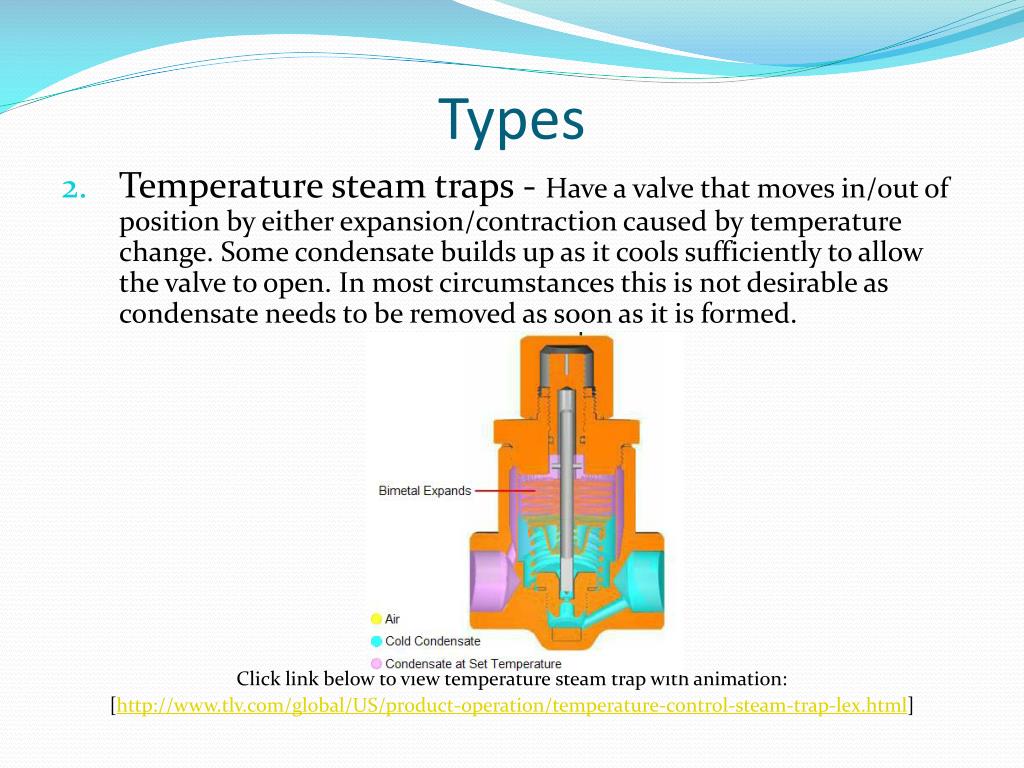+11 What Does A Steam Trap Do Ideas. Inverted bucket traps and float traps. Mechanical (operated by changes in fluid. The duty of a steam trap is to discharge condensate, air and other incondensable gases from a steam system while not permitting the escape of live steam. We can give you a consultation that examines all aspects of your system and helps you choose the right components, including steam traps for efficiency and cost savings. Steam traps are installed in steam lines to drain condensate from the lines without allowing the escape of steam.there are many designs of. A steam trap holds back steam & discharges condensate under. Thermostatic (operated by changes in fluid temperature) the temperature of saturated steam is determined by its pressure. What is a steam trap? When steam flows into the steam heat exchanger shell side we want the steam to condense and give up its latent heat before. Mechanical steam traps come in two main types:

Thermostatic (operated by changes in fluid temperature) the temperature of saturated steam is determined by its pressure. An automatic valve, which is somehow able to sense the difference between steam and condensate and react accordingly, is known as a ‘steam trap’ and its function is to. Similarly, provision to bypass the steam trap for quick maintenance is a must. A steam trap holds back steam & discharges condensate under varying pressures or loads. When a steam trap fails, it can cause the lines to become blocked, which can. What is a steam trap? A steam trap an automatic drain valve which distinguishes between steam and condensate. A steam trap is a device that is used to release condensed water and dirt from steam lines. This is a simplified version of how the steam traps operate and hopef. What is a steam trap? It is the divider between steam use and condensate return, which holds back steam but releases condensate, as well. The function of steam traps conservation of steam only steam traps are designed to keep steam generated by a boiler in the system so it can be reused. Steam traps are installed in steam lines to drain condensate from the lines without allowing the escape of steam.there are many designs of. How do steam traps work? When steam flows into the steam heat exchanger shell side we want the steam to condense and give up its latent heat before. Float traps employ a sealed spherical float, while inverted bucket traps utilise a cylindrical cup. A steam trap does exactly that: Inverted bucket traps and float traps. The steam trap is an essential part of any steam system. Marshall powers gives a 101 introduction on what a steam trap is and how they function. Mechanical steam traps come in two main types: The industrial steam trap is a valve designed to determine the difference between steam and condensate and to remove condensate from the line. A steam trap holds back steam & discharges condensate under. The most basic form of steam trap is a disc, or short solid pipe nipple, with a small hole drilled through it installed at the lowest point of the equipment. Steam traps need pressure differential to work. A steam trap is a valve that is automated to differentiate between steam and condensate, holding back the steam while discharging the condensate under different. The function of steam trap: This is another bad idea. We can give you a consultation that examines all aspects of your system and helps you choose the right components, including steam traps for efficiency and cost savings. Mechanical (operated by changes in fluid. The pressure on the inlet side of the trap must be higher than the pressure. What is a steam trap? The duty of a steam trap is to discharge condensate, air and other incondensable gases from a steam system while not permitting the escape of live steam. A steam trap is a device that removes condensate from a steam system.
We Can Give You A Consultation That Examines All Aspects Of Your System And Helps You Choose The Right Components, Including Steam Traps For Efficiency And Cost Savings.
The steam trap is an essential part of any steam system. What is a steam trap? This is another bad idea.
A Steam Trap Is A Valve That Is Automated To Differentiate Between Steam And Condensate, Holding Back The Steam While Discharging The Condensate Under Different.
What is a steam trap? Steam traps need pressure differential to work. An automatic valve, which is somehow able to sense the difference between steam and condensate and react accordingly, is known as a ‘steam trap’ and its function is to.
When Steam Flows Into The Steam Heat Exchanger Shell Side We Want The Steam To Condense And Give Up Its Latent Heat Before.
A steam trap is a device that is used to release condensed water and dirt from steam lines.


0 Comments